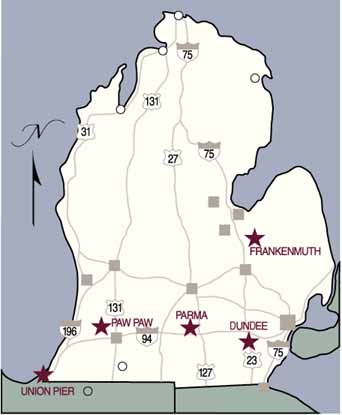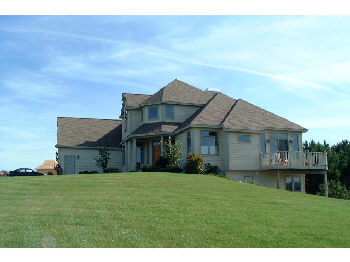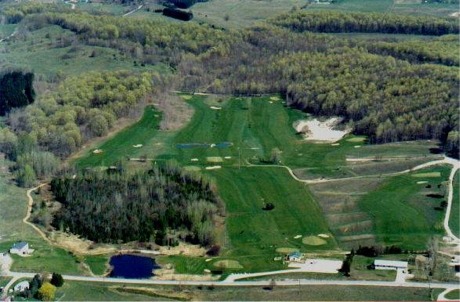Although anyone can make up to 200 gallons of wine for their own consumption (though you have to be 21 to drink it), most people prefer to buy commercially produced wine. As a result, since the 1970s there has been a steady growth of wineries in Michigan. However, Michigan has been producing wine commercially since the early 1900s.
St. Julian Winery was among the first commercial producers of wine in Michigan. St. Julian Winery was founded by Italian Imigrant Mariano Meconi as the Border City Wine Cellars in 1921. Due to prohibition in the US, Meconi set up shop in Windsor, Ontario where he could tap the huge demand for wine from neighboring Detriot. After prohibition was repealed in 1933, Meconi moved the winery to Detroit, but a falling out with his partner caused a split, with the partner getting the Detroit operation and Meconi moving his operation to the winery's vineyard location in Paw Paw (a smart move because it took 6 hours to drive the grapes from Paw Paw to Detroit along old US-12). He renamed the winery the Italian Wine Company. To avoid the anti-fascist feeling in the US during WW II, Meconi changed the name to St. Julian, the patron saint of his native home, Falaria, Italy. The winery has grown and flourished, proving that wine can be successfully grown in Michigan.

Locations of St. Julian's Tasting Rooms
Source: Michigan State University - Department of Geography
St. Julian's success, however, did not spur additional development of commercial wineries in Michigan until the 1970s when smaller operations began to convert cherry orchards to vineyards on the Leelanaw Peninsula, near Traverse City, and in the southwest of the State. A complete? list is provided by the Michigan Department of Agriculture Grape and Wine Industry Council.
Wineries in the Northwest Lower Peninsula
Nestled in the hills of Leelanau Peninsula or on the Old Mission Peninsula are no less than 17 wineries and many more vineyards. All produce wine from Michigan grapes to some extent. Some wineries are becoming renowned for specialty wines, such as Bel Lago for their sparkling wines (champaigne), and Chateau Grand Traverse for its cherry flavored wines. Most all of these wineries have tasting rooms on their premises and many even have fine restaurants and lodging. There can be few better ways of seeing the Traverse-Leelanau area than hopping from winery to winery - many of which offer spectacular views of Grand Traverse Bay.
Wineries in the Southwest and along Lake Michigan
Due to the excellent climate during the growing season, the southwest part of Michigan has also experienced a boom in wineries. Not only are they close to their vineyard sources, they also are near the main thoroughfare between Detroit and Chicago (I-94). Like their cousins to the north, these wineries all have tasting rooms, and many have restaurants. These wineries are known for later harvest wines (particularly red wines like Pinot Noir).
Michigan Winery Facts
- Michigan is currently ranked 13th (in terms of production volume) of the 49 States that produce wine.
- Sales of Michigan wines has risen 27% over the past 4 years.
- In 2000 Michigan wineries sold $17 million dollars worth of wine.
- October is officially "Michigan Wine Month" in Michigan.
- One acre of good quality vinifera grapes can bring up to $1500.
- Approximately 350,000 tourists visit Michigan wineries each year.
- There are several wine festivals held at Michigan wineries each year
- Many county fairs and the Michigan State Fair have Michigan wine tastings and competitions.
- Michigan wines have been rated excellent by several prestigeous wine publications.
Wine and Tourism
The Michigan wine industry is playing a growing role in Michigan tourism. Many people take a nice late summer weekend and go on a "wine tour." They start out either in Leelanau Co. or Berrien Co. and follow the string of wineries and vineyards up and down the Lake Michigan shore, stopping along the way for food and wine tasting and visiting other sites of local interest. There is little doubt that the presence of commercial wineries and vineyards in Michigan is a boon for the State's tourism industry attracting an estimated 350,000 visitors annually.
Wine and grape isses in Michigan

5 bedroom house overlooking west Traverse Bay on Old Mission Peninsula
2001 Price $540,000
Source: Photo courtesy of Karsten Shien

Recent golf course near Traverse Bay
Source: Unknonw
Grapes and people like the same sort of climate, not too hot, not too cold, not too
much rain, close to the lake shore. It is no suprise that land in places that meet
these conditions is at a premium. While the land is great for growing wine grapes,
it is being gobbled up at an alarming rate by developers and retirees who are building
large summer homes, subdivisions, and retirement castles on the once agricultural
lands. As people move into the areas, more land is needed to build shops and golf
courses. This can take even more land out of farming In addition to the
climate, one of the attractions of these locations are the feeling of being in "wine
country" surrounded by vineyards. However, many newcomers to these regions do
not like to be woken early in the morning by nearby farm operations and are attempting to
have the farms rezoned as residential property. Also, the appeal of the region
drives land prices up to the point where farmers may decide to sell for very large
profits. Thus the appeal of the vineyard in these areas may in the end push them out
of the area.
Wine links
- MI Grape and Wine Industry Council
- Northern Michigan Wineries
- Detroit News Wine Report
- Leelanau Co. Vintners Association
This material has been compiled for educational use only, and may not be reproduced without permission. One copy may be printed for personal use. Please contact Randall Schaetzl (soils@msu.edu) for more information or permissions.